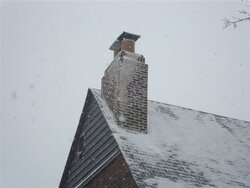Chettt said:My question is how likely is the creosote that is further away from the stove to ignite spontaneously if there is no chimney fire starting in the section of flue closest to the stove? It seems to my thinking that a chimney fire must start close to the heat source and then continue burning further up the flue. When it warms up for a day in January I pull the lower section of pipe that connects to the stove and brush out all the creosote figuring that my once per year complete clean in the summer will be fine if the first 10 feet are cleaned mid season. Am I wrong with this logic?
I think you're on the right track, but I'm sure not a chimney expert. I'd feel safe enough with that. Of course, it all depends on what you're pulling out of there. If you get 2-3 gallons of flake creosote out of the first 10 feet during your mid-season cleaning, I think you need to get a lot more aggressive. With my setup, I burn extremely hot every day for at least an hour all told. No exceptions ever. I can see right up to my elbow (about 3' up) with a light and mirror from inside my stove when the damper is open. I do this every time the stove is cool enough. On only a couple of occasions have I seen anything but clean metal. Those few times with soot and a bit of creosote in there I could have predicted ahead of time without looking, just by knowing I had had a poor burn the night before. 15 minutes at 600º on the flue pipe thermometer turns it all white again (single wall pipe, magnetic surface thermo).
I don't recommend that anyone try this unless their chimney has been freshly cleaned. An attempt to burn off all the creosote built up over a month long period of cold, wet burns could very likely precipitate the event you are trying to prevent.
As far as sparks and stuff, I really don't have an expert opinion to draw from, but the last time I pulled my pipe and elbow and looked up the flue, I was able to reach up and scrape a small amount of creosote off of the flue walls. I took this stuff - about a tablespoon - and put it on a metal plate and tried to light it with a butane BBQ lighter (this was before I talked to that stove tech). The idea was to show my oldest son how hazardous the stuff was. Best I could do was to get it to smolder and then go out once I pulled the lighter away. I fluffed it up and tried to give it as much air as I could. If some else tries this and gets a different result, put it on video for us all to see. To be honest, mine was about 50% soot and 50% flake creosote, so that may have been a contributing factor, because soot is almost all carbon and is, apparently, very hard to ignite. I'm very curious about all this, because until recently I had assumed it was a lot more flammable than what I am seeing and hearing.



 ! Mainly from the smoke shelf. He also stated he would be very carefull using it without a liner!! WTF the other guy never mentioned that! The first guy said I must have used the fire place insert and stove ALOT with bad wood to cause that much creosote! Anyway I hope the guy goes out of business before he kills somebody! I have spread the word as much as I can.....
! Mainly from the smoke shelf. He also stated he would be very carefull using it without a liner!! WTF the other guy never mentioned that! The first guy said I must have used the fire place insert and stove ALOT with bad wood to cause that much creosote! Anyway I hope the guy goes out of business before he kills somebody! I have spread the word as much as I can.....